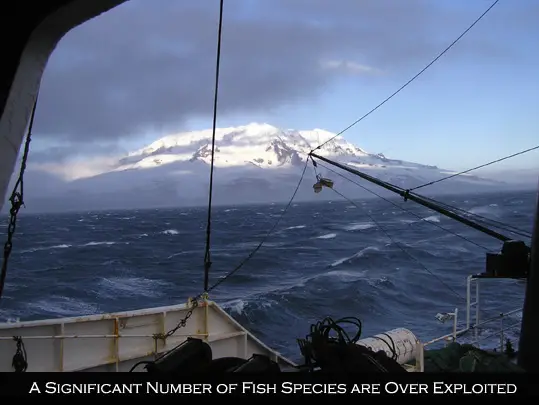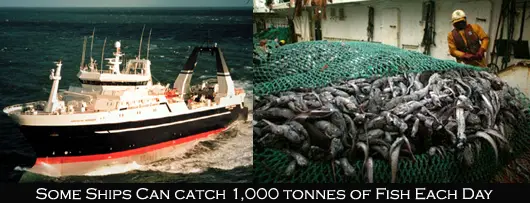Fishing and Climate Change: Millions of people around the world depend on fisheries and aquaculture, directly or indirectly, for their livelihoods. During the past three decades, the number of fishers and aquaculturists has grown faster than the world’s population, and employment in the fisheries sector has grown faster than employment in traditional agriculture.
In 2004, an estimated 41 million people worked (part time or full time) as fishers and fish farmers, accounting for 3.1 percent of the 1.36 billion people economically active in agriculture worldwide and representing a growth rate of 35 percent from the corresponding figure of 2.3 percent in 1990. The great majority of fishers and fish farmers are in developing countries, principally in Asia. Significant increases over recent decades, in particular in Asia, reflect the strong expansion of aquaculture activities.

World Fishing Fleets
According to the World Review of Fisheries and Aquaculture, and at the end of 2004, the world fishing fleet consisted of about 4 million units, of which 1.3 million were decked vessels of various types, tonnage and power, and 2.7 million were undecked (open) boats. While virtually all decked vessels were mechanized, only about one-third of the undecked fishing boats were powered, generally with outboard engines. The remaining two-thirds were traditional craft of various types, operated by sail and oars.
About 86 percent of the decked vessels were concentrated in Asia, followed by Europe (7.8 percent), North and Central America (3.8 percent), Africa (1.3 percent), South America (0.6 percent) and Oceania (0.4 percent). A 2006 report by the University of British Columbia put worldwide annual government spending on fisheries subsidies at about USD 34 billion. Of that, environmentalists blame some USD 20 billion in harmful payments, such as those that go toward building new fishing boats, for three-quarters of the world’s overfishing. Japan, the EU, and China are the biggest subsidisers, respectively doling out about USD 5.3 billion, USD 3.3 billion, and USD 3.1 billion annually.
Marine Fish Stocks
Most of the stocks of the top ten species, which account in total for about 30 percent of the world capture fisheries production in terms of quantity, are fully exploited or overexploited and therefore cannot be expected to produce major increases in catches.
This is the case for the anchoveta (Engraulis ringens), with two main stocks in the Southeast Pacific that are fully exploited and overexploited; the Alaska pollock (Theragra chalcogramma), which is fully exploited in the North Pacific; the blue whiting (Micromesistius poutassou), which is overexploited in the Northeast Atlantic; the Atlantic herring (Clupea harengus), with several stocks that are fully exploited and others that are recovering from depletion in the North Atlantic; the Japanese anchovy (Engraulis japonicus), which is fully exploited in the Northeast Pacific; the Chilean jack mackerel (Trachurus murphyi), which is fully exploited and overexploited in the Southeast Pacific; and the yellowfin tuna (Thunnus albacares), which is fully exploited in the Atlantic and Pacific Oceans and probably moderately to fully exploited in the Indian Ocean.
Globally, Bigeye Tuna is classified as Vulnerable by the IUCN13 while the Pacific Ocean stock is classified as Endangered (IUCN, 2006).
Some stocks of skipjack tuna (Katsuwonus pelamis) are fully exploited and chub mackerel (Scomber japonicus), are moderately exploited in the Eastern Pacific while other stocks are already fully exploited. The largehead hairtail (Trichiurus lepturus) is considered fully overexploited in the main fishing area in the Northwest Pacific, but its state of exploitation is unknown elsewhere.

Status of Fish Stocks
The status of the world’s fish populations and the health of the ocean is alarming. In November 2006, some of the world’s top ecologists and economists issued a study that projects “the global collapse of all taxa currently fished by the mid-21st century”. It has been said that 90% of all large fish in the ocean are gone (Myers and Worm, 2003). Overall, more than 75 percent of world fish stocks for which assessment information is available are reported as already fully exploited or overexploited (or depleted and recovering from depletion), reinforcing earlier observations that the maximum wild capture fisheries potential from the world’s oceans has probably been reached and calls for a more cautious and closely controlled development and management of world fisheries.
An international group of leading ecologists and economists have warned that worldwide fisheries could totally collapse by 2048 if no action is taken to halt current levels of overfishing. In findings from an extensive global study published in the journal Science, they said that at current rates, fish stocks risked declining to an extent that would render commercial fishing impossible and recovery unlikely. The four-year evaluation found that about one third of open sea fisheries have already collapsed, a trend exacerbated by the changes produced by broader losses in marine biodiversity. The researchers pointed to fishing, pollution, climate change, increasing acidity of the ocean and the destruction of marine habitats as some of the key factors for the decline.
A Canadian-led research team also warns the world’s fisheries are on track to collapse by the middle of this century, unless there is a revolutionary change to the management of fishing resources. The team projects the global collapse of all taxa (species) currently being fished by the mid-21st century. The team notes bigger boats and new technology are chasing fewer fish the global catch fell by 13 per cent between 1994 and 2003.
The over-exploitation and mismanagement of fisheries has already led to some spectacular fisheries collapses. The cod fishery off Newfoundland, Canada collapsed in 1992, leading to the loss of some 40,000 jobs in the industry. The cod stocks in the North Sea and Baltic Sea are now heading the same way and are close to complete collapse.
Another international team of researchers have demonstrated that commercial fishing compromises a species’ ability to buffer itself from environmental variations such as El Niño, resulting in a “double jeopardy” situation in which populations are depleted by the fishing itself and also made more vulnerable to threats other than fishing. The scientists reported that fished populations tend to show more extreme variations because fishing selectively culls the larger, older individuals, the fish that are most able to buffer random environmental variations. Those individuals also tend to be the most reproductively active. In a fished population, the average size and age of individuals decline and the resultant stock of near-juveniles is less able to cope with environmental stresses. (Scripps Institution of Oceanography at the University of California at San Diego; the Southwest Fisheries Science Center of the U.S. National Marine Fisheries Service; Imperial College, London; and the University of Oxford.)
Illegal, Unreported and Unregulated (IUU) Fishing
IUU fishing undermines national and regional efforts to conserve and manage fish stocks and, as a consequence, inhibits progress towards achieving the goals of long-term sustainability. IUU fishing also greatly disadvantages and discriminates against those fishers that act responsibly, honestly and in accordance with the terms of their fishing authorizations. This is a compelling reason why IUU fishing must be dealt with quickly and in a transparent manner. If IUU fishing is not curbed, and if IUU fishers target vulnerable stocks that are subject to strict management controls or moratoria, efforts to rebuild those stocks to healthy levels will not be achieved.
Fishing and Climate Change
“An expected characteristic of global climate change is a likely increase in the variability of environmental conditions. Experience already gained in dealing with longer term fluctuations in marine environments, such as those induced by El Niño events, emphasize the need for adaptability. As well, ensuring sustainable economic levels of fishing capacity should be determined with the variability in mind. The effects of climate change on fisheries will impact a sector that is already characterized by full utilization of resources, large overcapacity and conflicts among fishers, and others, vying for alternative uses of marine ecosystems. Thus, climate change adds a further argument for developing effective and flexible fisheries management system in an ecosystem context.”FAO – The United Nations
Today, more people than ever depend on marine fisheries but the ocean’s ability to meet their needs is in grave danger. Cultured fish now accounts for about a third of all fish consumed in the world, and the U.S. and other nations are looking for ways to reduce the amount of fish they import. Yet in the U.S. and elsewhere, proposed aquaculture laws fail to set environmental standards or sustainable management tools for these marine based fish farms.
